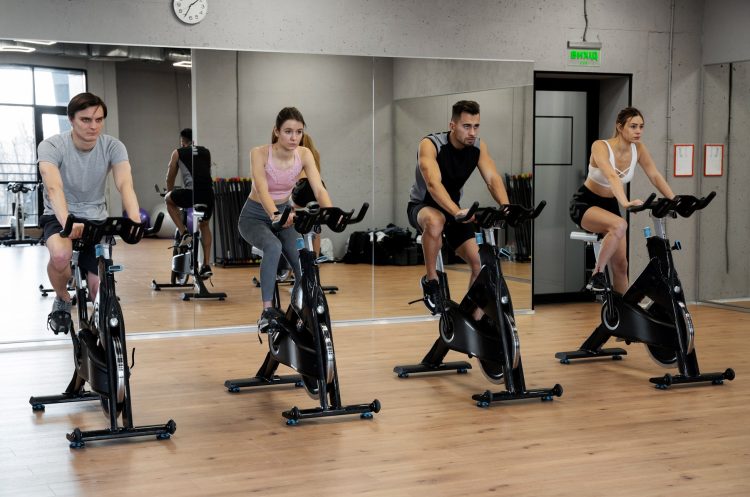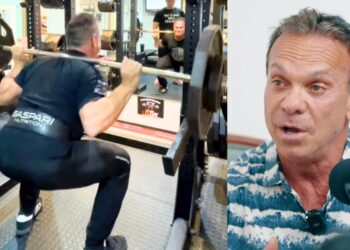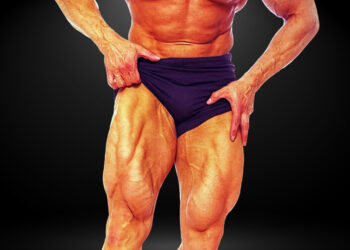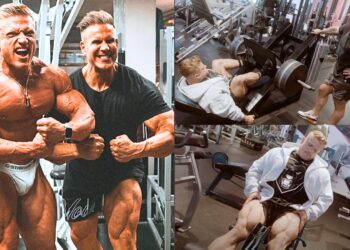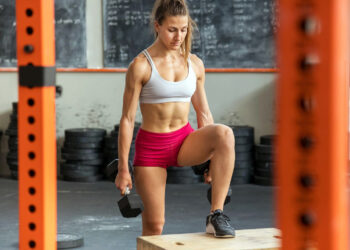Knee pain is a common problem that can affect exercisers of all ages. Studies suggest that 50% or more of adults will experience knee pain at some time or another, and rates of knee pain are on the rise (1).
The causes of knee pain can be complex but include:
- Osteoarthritis
- Muscle weaknesses or imbalances
- Muscle tightness
- Too many repetitive movements
- Excessive high-impact activity
- Injury to the ligaments responsible for stabilizing the knee joint
- Damage to the articular cartilage
- Damage to the patella or kneecap
Needless to say, if you have a bonafide injury, you should seek medical attention. Your knee issue may require treatment and, in some cases, immobilization and rest. However, if your symptoms are mild and you’ve been told it’s okay to do so, you should do your utmost to continue training your legs.
After all, friends don’t let friends skip leg day, right?!
I don’t mean you should ignore the pain and push through it. Instead, you should modify your workouts to preserve or increase strength and muscle mass without aggravating your joints.
As a veteran personal trainer with over 30 years of experience, plus a background in sports massage, I’ve helped many clients train around and overcome knee pain. In this article, I share one of my favorite workouts for exercisers with sore knees.
Level Up Your Fitness: Join our 💪 strong community in Fitness Volt Newsletter. Get daily inspiration, expert-backed workouts, nutrition tips, the latest in strength sports, and the support you need to reach your goals. Subscribe for free!
Warm-Up for Sore Knees
All good workouts should start with a thorough warm-up, especially when you have knee pain. Warming up increases blood flow, tissue temperature, and synovial fluid production, all of which will make your knees more supple and mobile.
Skipping your warm-up means more wear and tear for your joints and a less comfortable workout.
So, long story short – never skip your warm-up!
Follow these steps to ensure your muscles and joints are ready for the workout ahead.
Pulse raiser – this is the part of the warm-up that makes you warm! It gets your blood pumping and raises your temperature. It also increases synovial fluid production, which is a lubricating, nourishing substance produced within your joints.
Stationary cycling is an excellent option for sore knee sufferers, but you can also use an elliptical or rower. However, avoid jumping on a treadmill and jogging or running, as the impact could make your sore knees worse.
Joint mobility exercises – your joints should feel pretty mobile after your pulse raiser. Still, there is no harm in ensuring that they’re moving as freely as possible. Take your ankles, knees, and hips through a gradually increasing range of motion by flexing, extending, and rotating your limbs. For example:
- Ankle circles
- Shallow progressing to deeper bodyweight squats
- Leg swings and hip circles
Continue each exercise until your joints feel supple and mobile.
Dynamic flexibility – next, you need to stretch the muscles you are about to work. This will reduce tension and increase the range of motion.
Dynamic flexibility exercises involve moving your muscles in and out of an elongated position and are performed for reps. In contrast, static stretches involve holding the elongated position for time.
Dynamic stretches are generally best for warming up because they maintain your core temperature and increase muscle activation. Conversely, static stretches tend to make your muscles relax, potentially reducing their strength.
Simply do 10-15 reps of 1-2 exercises for each of the muscle groups you are about to train, e.g.:
- Forward alternating leg swings (hamstrings)
- Alternating “butt kickers” (quads)
- Alternating knee hugs (glutes)
Are you warmed up and feeling good? Then let’s get to work!
Workout Overview
Do the following workout 1-2 times per week. If you do it twice, make sure you leave a couple of days in between for rest and recovery, e.g., Monday and Thursday.
Sets and reps are for illustrative purposes only, so feel free to modify them according to your needs and goals.
| Exercise | Sets | Reps | Recovery | |
| 1 | Box Squat | 4-5 | 6-8 | 2 minutes |
| 2 | Romanian Deadlift | 4-5 | 6-8 | 2 minutes |
| 3 | Reverse Lunge | 3-4 | 8-10 per leg | 90 seconds |
| 4 | Barbell Hip Thrust | 3-4 | 8-10 | 90 seconds |
| 5 | Isometric Wall Squat Hold | 2-3 | 20-40 seconds | 60 seconds |
| 6 | Seated Calf Raise | 2-3 | 10-12 | 60 seconds |
| 7 | Standing Calf Raise | 2-3 | 12-15 | 60 seconds |
Maximize the effectiveness of this workout while minimizing your risk of joint pain and injury by performing each exercise correctly. Follow these step-by-step instructions for maximal gains and minimal strains!
1. Box Squat
Box squats are one of the most knee-friendly squat variations around. The box limits your range of motion and ensures you descend slowly and with control. So, even if regular barbell squats bother your knees, you’ll probably be okay with box squats.
How to do it:
Level Up Your Fitness: Join our 💪 strong community in Fitness Volt Newsletter. Get daily inspiration, expert-backed workouts, nutrition tips, the latest in strength sports, and the support you need to reach your goals. Subscribe for free!
- Rack and hold your barbell across your upper back.
- Stand with your back to a knee height or slightly higher bench or box. Your feet should be roughly shoulder-width apart, toes pointing slightly outward.
- Brace your core and look straight ahead.
- Bend your knees and descend until your butt rests on your box.
- Pause for 1-3 seconds, but do not relax.
- Drive your feet into the floor and stand back up.
- Reset your core and repeat.
Learn more about box squats in this in-depth guide.
2. Romanian Deadlift
The Romanian deadlift is one of the best ways to strengthen your entire posterior chain, which is the collective term for your hamstrings, glutes, and lower back. Performed correctly, it’s also a much more knee-friendly exercise than conventional deadlifts. This popular movement offers a lot of bang for your workout buck!
How to do it:
- Hold a barbell with an overhand, shoulder-width grip.
- Stand with your feet shoulder-width apart.
- Pull your shoulders down and back, and brace your core.
- Keeping your knees slightly bent but rigid, push your butt back and hinge forward from your hips. Lower the bar down the front of your legs as far as possible without rounding your lower back.
- Stand back up, straight repeat.
3. Reverse Lunge
Reverse lunges are a knee-friendly alternative to regular lunges. However, they work all of the same muscles. Lunges are a unilateral or single-leg exercise that’s ideal for identifying and fixing left-to-right strength imbalances. They also provide an excellent workout for your hip adductors and abductors, located on the inside and outside of your legs.
How to do it:
- Stand with your feet together, a dumbbell in each hand (optional), and arms by your sides.
- Brace your core and pull your shoulders back and down.
- Take a large step backward, bend your legs, and lower your rear knee to within an inch of the floor. Keep your front knee well behind your toes.
- Push off your back leg and return to the starting position.
- Repeat with your opposite leg.
- Alternate sides for the required number of reps.
Read more about how reverse lunges are a great alternative to forward lunges.
4. Barbell Hip Thrust
The barbell hip thrust is another posterior chain exercise that puts very little stress on your knees. It’s also very lower back-friendly, which is another significant benefit. Place a folded gym mat or towel between the barbell and your hips. Otherwise, this exercise can leave you with unwanted bruises.
How to do it:
- Sit on the floor with your upper back resting against a sturdy bench.
- Rest and hold a barbell across your hips. Bend your legs and plant your feet firmly on the floor. Brace your core.
- Push your feet into the floor and lift your hips until they form a straight line with your knees and shoulders.
- Lower your butt back to the floor and repeat.
5. Isometric Wall Squat
Isometric exercises involve lots of muscle tension but no actual joint movement. As such, they’re an excellent option for anyone with sore knees. The isometric wall squat provides a great way to finish off your legs without hammering your joints. As such, they’re a tremendous alternative to leg extensions.
How to do it:
- Stand with your back to a smooth wall or pillar, feet about hip-width apart.
- Lean back and slide down until your thighs are roughly parallel to the floor.
- Push your butt and lower back into the wall as hard as you can.
- Hold this position until your quadriceps are shaking and burning.
- Rest a moment and repeat.
6. Seated Calf Raise
No leg workout is complete without a couple of calf exercises. After all, well-developed calves add a lot to the appearance of your lower body. Seated calf raises target your soleus, which is the lowermost calf muscle.
How to do it:
- Sit on the seated calf raise machine and place the balls of your feet on the footrest. Place the leg pad across your lower thighs. Release the safety catch.
- Lower your heels as far down as possible, getting a good stretch in your calves.
- Rise up onto your tiptoes and pause for 1-2 seconds.
- Lower your heels and repeat.
7. Standing Calf Raise
Standing calf raises work your gastrocnemius and soleus, which are your upper and lower calf muscles. Subsequently, if you only have time or energy for one lower leg exercise, standing calf raises should be the one you choose.
How to do it:
- Put your shoulders under the pads and the balls of your feet on the footrest. Stand up straight and brace your core. Hang onto the handles for balance.
- Lower your heels as far down as possible, getting a good stretch in your calves.
- Rise up onto your tiptoes and pause for 1-2 seconds.
- Lower your heels and repeat.
Check out this article to learn more about Standing vs. Seated Calf Raises.
Tips for Knee-Friendly Workouts
Make your leg workouts even more knee-friendly and comfortable with these tried and tested tips!
Warm-up for longer – having a bad knee day? Spend longer on your warm-up to really get that synovial fluid flowing.
Train light but slow – slow tempo training makes light weights feel heavy without overloading your joints. Try lifting and lowering for three seconds each for a challenging, low-load workout.
Wear knee sleeves – neoprene and elasticated knee sleeves provide warmth and support for your hard-working joints. They’re an excellent investment for knee pain sufferers.
Stabilize your knees – don’t allow your legs to cave in or fall out during squats and other leg presses, as doing so puts unnecessary stress on the medial and lateral aspects of the knee joints. Instead, make sure you keep your knees in line with your toes.
Achieve and maintain a healthy body weight – being overweight puts tremendous stress on your knees. Studies suggest that losing weight can help alleviate knee pain in some people (2). Taking care of your knees should be your priority 24/7, and not just during your workouts.
Closing Thoughts
Sore knees can make leg training an unattractive prospect. However, provided you avoid joint-stressful exercises like leg extensions, leg presses, deep squats, and forward lunges, many exercisers can train their legs without undue pain and discomfort. In fact, strength training has been shown to be an effective intervention for knee pain (3).
That said, if your knees hurt, it’s best not to ignore them. While you can often work around knee pain, some causes require medical treatment or rest. Seek medical attention if your knee pain is severe or worsens.
References:
- Nguyen US, Zhang Y, Zhu Y, Niu J, Zhang B, Felson DT. Increasing prevalence of knee pain and symptomatic knee osteoarthritis: survey and cohort data. Ann Intern Med. 2011 Dec 6;155(11):725-32. doi: 10.7326/0003-4819-155-11-201112060-00004. PMID: 22147711; PMCID: PMC3408027.
- Messier SP, Resnik AE, Beavers DP, Mihalko SL, Miller GD, Nicklas BJ, deVita P, Hunter DJ, Lyles MF, Eckstein F, Guermazi A, Loeser RF. Intentional Weight Loss in Overweight and Obese Patients With Knee Osteoarthritis: Is More Better? Arthritis Care Res (Hoboken). 2018 Nov;70(11):1569-1575. doi: 10.1002/acr.23608. PMID: 29911741; PMCID: PMC6203601.
- Lun V, Marsh A, Bray R, Lindsay D, Wiley P. Efficacy of Hip Strengthening Exercises Compared With Leg Strengthening Exercises on Knee Pain, Function, and Quality of Life in Patients With Knee Osteoarthritis. Clin J Sport Med. 2015 Nov;25(6):509-17. doi: 10.1097/JSM.0000000000000170. PMID: 25591130.

